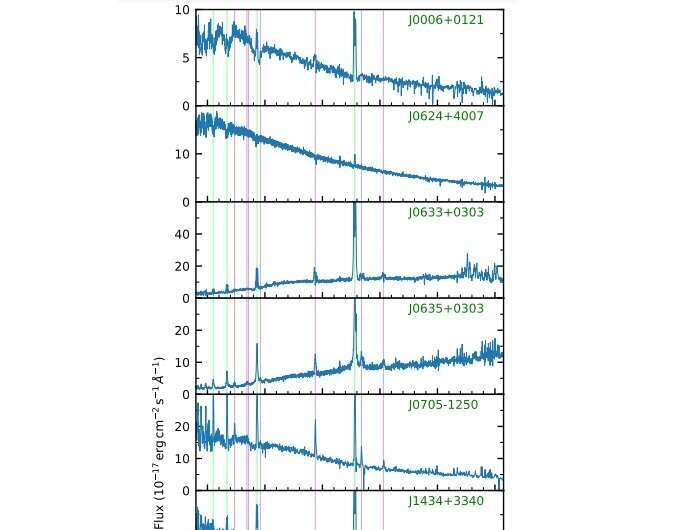May 30, 2023 report
This article has been reviewed according to Science X's editorial process and policies. Editors have highlighted the following attributes while ensuring the content's credibility:
fact-checked
preprint
trusted source
proofread
Astronomers discover eight new cataclysmic variables

An international team of astronomers has analyzed the data from the latest phase of the Sloan Digital Sky Survey (SDSS). They discovered eight new cataclysmic variables (CV) systems. The finding is reported in a paper published May 22 on the arXiv pre-print server.
CVs are binary star systems consisting of a white dwarf primary that is accreting matter from a normal star companion. They irregularly increase in brightness by a large factor, then drop back down to a quiescent state. These binaries have been found in many environments, such as the center of the Milky Way galaxy, the solar neighborhood, and within open and globular clusters.
SDSS is an important tool in the search for CVs as so far more than 500 objects of this type have been identified as part of this survey. The project has now entered its fifth phase (SDSS-V), which extends multi-object spectroscopy across the entire sky by operating robotic fiber positioners on the 2.5 m SDSS telescope at Apache Point Observatory (APO) and at the 2.5 m Dupont telescope at Las Campanas Observatory.
Given that SDSS-V contains a program to deliberately target white dwarfs and cataclysmic variable systems, a group of astronomers led by Keith Inight of the University of Warwick, UK, decided to use it in order to search for new CVs and to characterize the ones already detected.
"SDSS-V is, for the first time, carrying out a dedicated survey of white dwarfs, both single and in binaries. We have analyzed the SDSS-V spectra of CVs and CV candidates observed as part of the final plug-plate operations of SDSS, and we discovered eight new CVs," the researchers wrote in the paper.
Out of the eight newly discovered cataclysmic variables, four turned out to be WZ Sagittae (WZ Sge) systems—non-magnetic CVs showcasing low accretion rate and rare superoutbursts. There is also one nova-like (NL) CV, one of the SU Ursae Majoris (SU UMa) subtype and one polar (due to the presence of a very strong magnetic field in its white dwarf). The subclass of the remaining one CV is yet to be determined.
According to the study, none of the newly identified CVs displays noticeable changes in brightness in their light curves. The orbital periods of all these eight CVs were measured to be below 94 minutes, which is typical for old, low accretion rate systems. This suggests that SDSS-V will continue to increase the proportion of short-period cataclysmic variables among the known population of CVs.
"This is consistent with previous findings that spectroscopically identified CVs have a larger proportion of short-period systems compared to samples identified from photometric variability," the authors of the paper noted.
Besides the detection of new cataclysmic variables, the astronomers also spectroscopically confirmed 53 and refuted 11 other CV candidates. Moreover, they were able to measure orbital periods for 21 CV systems.
More information: K. Inight et al, Cataclysmic Variables from Sloan Digital Sky Survey V—the search for period bouncers continues, arXiv (2023). DOI: 10.48550/arxiv.2305.13371
Journal information: arXiv
© 2023 Science X Network



















